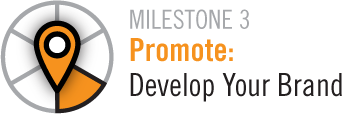

You know your values and skills, and now it’s time to promote them in a compelling professional brand that’s all about you. Learn how to create an effective resume and cover letter, master a job interview, enhance your online presence, and much more.
Learn to Tell Your Story Effectively Through Interviews
An interview gives the employer an opportunity to get to know you and determine if your skills and experiences match the organization's needs. Your goal in an interview is to demonstrate your communication skills, sell yourself, and determine if the opportunity is an optimal fit. The type of interview and format utilized by a potential employer will vary and your preparation will need to be customized accordingly:
Traditional(One-on-One)
Panel (Two or More Interviewers)
Group (Several Candidates Together)
Meal (Breakfast, Lunch or Dinner Interview)
Video-Recorded Responses
Video Interview
Phone Interview
In Person Interview
In addition to the type and format, an employer may use different interview styles to try to identify the best candidate.
 Case Interview - the applicant is given a question, situation, problem or challenge and asked to
resolve the situation.
Case Interview - the applicant is given a question, situation, problem or challenge and asked to
resolve the situation.
 Testing Interview – the interviewer may ask you to take a short test to evaluate your technical
knowledge or you may be required to give a presentation to demonstrate your communication
skills.
Testing Interview – the interviewer may ask you to take a short test to evaluate your technical
knowledge or you may be required to give a presentation to demonstrate your communication
skills.
 Structured Interview – the interviewer has a pre-planned set of questions and asks those
questions to every candidate
Structured Interview – the interviewer has a pre-planned set of questions and asks those
questions to every candidate
 Behavioral Interview – the interviewer poses questions that require you to demonstrate how
you handle situations
Behavioral Interview – the interviewer poses questions that require you to demonstrate how
you handle situations
The most common interview style is Behavioral. Employers like this approach because it allows them to understand what kinds of behaviors you use to solve problems. In your interview responses, you must rely on storytelling to get across why you are the best candidate for the role.
To answer typical questions like “Tell Me About a Time You Experienced a Conflict” or “Tell Me About a Project that Best Exemplifies Your Organizational Skills”, you need to use the STAR Method.
Review the Interviewing Guide to learn more about the STAR Method and the following topics:
- How to prepare for an interview
- Sample questions for the interviewer
- How to close an interview
- Day of the interview
- After the interview
To become an effective interviewer, it is critical that you practice and the CPD is here to support you:
 Mock Interview – Contact our office at 336-334-5454 to schedule a session to practice interviewing with a career coach. To maximize the effectiveness of this session, we recommend that you bring your resume along with the job or internship description for a role you are currently pursuing (or would like to pursue in the future). We will practice with you and give feedback to help you effectively tell your story in interviews.
Mock Interview – Contact our office at 336-334-5454 to schedule a session to practice interviewing with a career coach. To maximize the effectiveness of this session, we recommend that you bring your resume along with the job or internship description for a role you are currently pursuing (or would like to pursue in the future). We will practice with you and give feedback to help you effectively tell your story in interviews.
 Big Interview – The CPD sponsors this interactive online video-based interviewing tool which uses a webcam to video record a practice interview from any computer. InterviewStream features hundreds of interview questions by job/industry to customize your practice to roles you will pursue.
Big Interview – The CPD sponsors this interactive online video-based interviewing tool which uses a webcam to video record a practice interview from any computer. InterviewStream features hundreds of interview questions by job/industry to customize your practice to roles you will pursue.
Tips:
- Access the InterviewStream User Guide on the site’s Dashboard under Resources
- We have a technology room in the CPD for students to use if they don't have a webcam on their own computer
- Students are encouraged to shared their recorded videos with a career coach to receive feedback
- Access the User Guide in the site’s Dashboard under Resources - the guide will show you how to complete a mock interview and how to share a completed interview and request feedback
 Make a Strong First Impression – Guide to Professional Dress
Make a Strong First Impression – Guide to Professional Dress
You never get a second chance to make a first impression. Dressing professionally shows a potential employer that you take the opportunity, your career, and yourself seriously. The CPD requires professional dress at Career Fairs and other annual events, so we encourage you to start building your professional wardrobe early!
 Business Professional: What to Wear for an Interview & Career Fair
Business Professional: What to Wear for an Interview & Career Fair
- Invest in a good quality suit (black, dark grey, brown or navy) and a standard long-sleeve button-up dress shirt (white or solid light blue) or basic shell in understated colors
- Maintain a “less is more” mentality with makeup, nail polish, lipstick and jewelry
- Shoes should be closed-toed, simple and professional (avoid heels higher than two inches)
- Socks, hosiery, belts and accessories should be in matching neutral tones
- Ties should be solid colors, stripes, or small patterns
- Skirts should be no shorter than knee-length
- Carry a portfolio or briefcase large enough to carry your unfolded resume or other materials
 What is Business Casual?
What is Business Casual?
Some work environments are business casual and on many occasions, you may be invited to networking opportunities where the recommended dress is business casual. Here is what to wear:
- Shirts and sweaters as well as short-sleeve blouses
- Slacks, corduroy pants, khakis, skirts
- Relaxed, but professional shoes including loafers and open-toe shoes
Note: As a job seeker, it is strongly recommended that you do not wear jeans when attending networking events. Although there is a trend around “dressy casual” that includes nice jeans, that is best utilized once you actually have the job.
 Other Tips for Success
Other Tips for Success
- Investigate the organization where you are interviewing to see what the average employee wears
- A good guideline is to always dress more formally than would be expected on the job
- Make sure you are well-groomed and your attire is laundered, pressed and wrinkle-free
- Make sure clothes fit correctly and are not too loose or too tight
- Avoid anything that is too trendy or “loud”
















